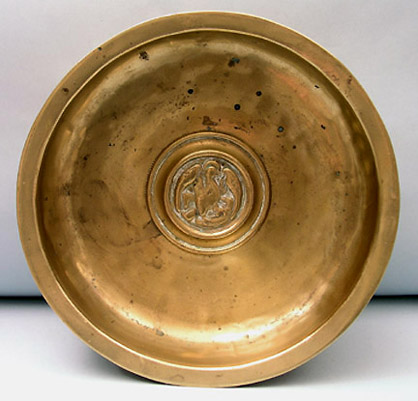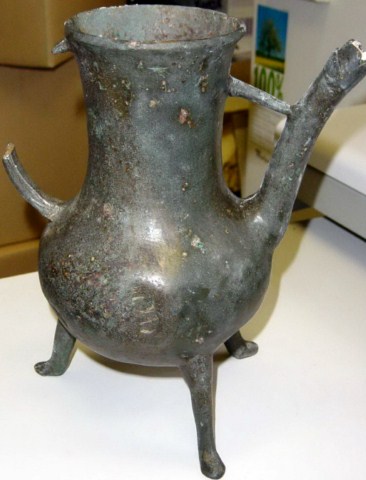 According to certain writers the "dinanderie" of the Middle Ages would have been a ressurection of the Rolman metal workings of the ‘Entre Meuse and Rhin’.
According to certain writers the "dinanderie" of the Middle Ages would have been a ressurection of the Rolman metal workings of the ‘Entre Meuse and Rhin’.
Thanks to deposits of calamines and ‘derle’ ( a plastic type of clay used in the fabrication of melting pots) but also thanks to the presence of fuel (forests) and hydraulic power the valley of the Meuse and particularly Dinant was its cradle. The communication routes, river and road, were favorable to its expansion and furthermore the importation of copper from Germany. The copper beaters appeared in Dinant around the XII century. They assembled into a corporation and got their status in 1255.
This craft is one of the only to have taken the name of the town in which it was born.
The reputation and quality of the products from this industry was so good that the Dinant copper beaters entered into the ‘hanseatic league’. This was an alliance of trading guilds that established and maintained a trade monopoly over the Baltic sea and most of Northern Europe for a time in the later Middle Ages and Early Modern period between the 13th and 17th century. To help sell its products on the English market they possessed a hall, in London, as of 1329.
The natural metal copper offers a red colouration. This metal is very malleable cold and rusts very little in a dry atmosphere but in a damp environment gets covered in a blue / green oxide called copper carbonate. Its fusion temperature is 1050°c.
Brass, or yellow copper is an alloy of 56% of red copper and zinc, calamine, and a small quantity of pewter and lead.
The melting process is very ancient and goes back to the Bronze Age. It consists of pouring the metal into a ready made mould. All the pieces made before the XVI century were made with this technique. The work of the smelter is one of many operations: making the alloy, preparation of the mould, the pouring, removing the cast and the finishing. Finishing consists of removing superfluous metal, polishing, the engraving and assembly of pieces moulded separately.
At the beginning of the XV century certain writers estimated that one in seven Dinantais were copper craftsmen. At this time the Dinantais had such a reputation that they were called the ‘copères’, derived from the English word ‘copper’. After the ransacking of 1466 the craftsmen who fled took refue in other towns in Belgium and abroad but the town’s name still stayed attached to their art. Today, very little is left, a workshop in Leffe, evening classes organized by the ‘Institut d’Enseignement Technique de L’Etat’ and a few artists.

A relic of a Dinandier’s oven from the XVI century (being excavated)
at Bouvignes north district, 2003.